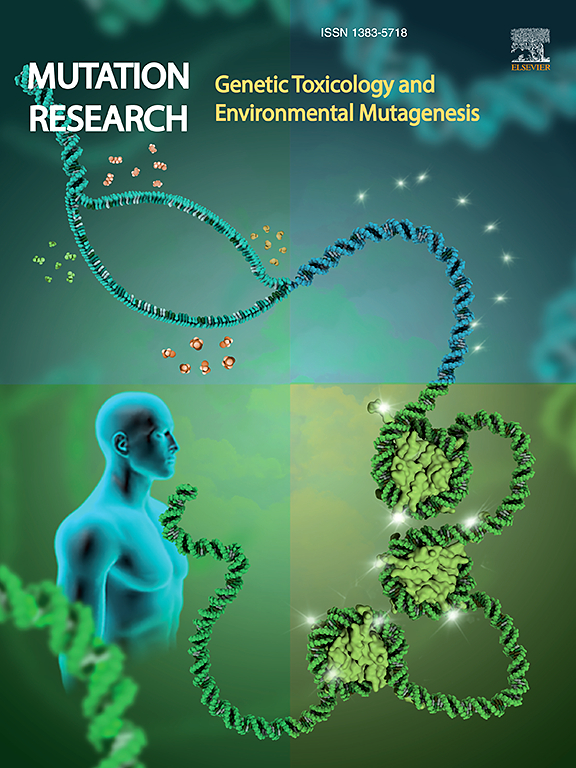利用Hawk-Seq™对诱变剂诱导的TK6细胞全基因组突变进行分析
IF 2.5
4区 医学
Q3 BIOTECHNOLOGY & APPLIED MICROBIOLOGY
Mutation research. Genetic toxicology and environmental mutagenesis
Pub Date : 2025-07-01
DOI:10.1016/j.mrgentox.2025.503875
引用次数: 0
摘要
错误校正的下一代测序(ecNGS)可以灵敏地检测生物模型中的罕见突变。我们使用Hawk-Seq™来评估IVGT TK6人淋巴母细胞样细胞系的化学诱导突变。由于克隆和亚克隆变异(CVs和scv)降低了突变检测的敏感性,我们首先通过对TK6基因组进行重测序,鉴定出与GRCh38相比的4,501,430个CVs。在滤除这些变异后,车辆对照的总体碱基替换(BS)频率为2.0 × 10−6碱基对(bp),相对高于其他ecNGS研究。在≥ 2个载体对照中,共有4974个位点提供了相同类型的BSs,这表明scv增加了错误频率。过滤这些位点后,总体背景BS频率显著降低(0.93 × 10−6 bp)。因此,我们通过增加深度(平均深度约为110)的重测序数据过滤出潜在的SCV位置,将背景总BS频率降低到0.65 × 10−6 bp。最后,我们评估了暴露于n -甲基-n -亚硝基脲(MNU)和n -乙基-n -亚硝基脲(ENU) 24 h的TK6细胞的DNA样本。MNU和enu处理后样品的总BS频率分别为9.0 × 10−6 bp和2.0 × 10−6 bp,显著提高了信噪比。MNU主要诱导G:C >; A:T(21 × 10−6 bp),比对照高62倍。ENU主要诱导G:C >; A:T频率(2.7 × 10−6 bp),显著增加A:T >; C:G和A:T >; G:C频率(~ 10−7 bp)。我们的方法灵敏地检测突变,包括次要模式,表明其反映各种致突变机制的潜力。本文章由计算机程序翻译,如有差异,请以英文原文为准。
Genome-wide mutation analysis induced by mutagens in TK6 cells using Hawk-Seq™
Error-corrected next-generation sequencing (ecNGS) sensitively detects rare mutations in biological models. We applied Hawk-Seq™ to evaluate chemical-induced mutations using the IVGT TK6 human lymphoblastoid cell line. Since clonal and sub-clonal variants (CVs and SCVs) decrease mutation detection sensitivity, we first identified 4,501,430 CVs compared to GRCh38 by resequencing the TK6 genome. The overall base substitution (BS) frequency in vehicle controls after filtering out these variants was 2.0 × 10−6 base pairs (bp), relatively higher than in other ecNGS studies. A total of 4974 sites provided the same types of BSs in ≥ 2 vehicle controls, suggesting that SCVs increased the error frequency. After filtering out these sites, the overall background BS frequency significantly decreased (0.93 × 10−6 bp). Therefore, we filtered out the potential SCV positions identified using resequencing data with increased depth (mean depth of ca. 110), reducing the background overall BS frequency to 0.65 × 10−6 bp. Finally, we evaluated DNA samples from TK6 cells exposed to N-methyl-N-nitrosourea (MNU) and N-ethyl-N-nitrosourea (ENU) for 24 h. The overall BS frequencies in MNU- and ENU-treated samples were 9.0 × 10−6 and 2.0 × 10−6 bp, respectively, significantly improving the signal-to-noise ratio. MNU predominantly induced G:C > A:T (21 × 10−6 bp), 62 times higher than that induced by vehicle controls. ENU primarily induced G:C > A:T (2.7 × 10−6 bp) and significantly increased A:T > C:G and A:T > G:C frequencies (∼10−7 bp). Our method sensitively detected mutations, including minor patterns, indicating its potential to reflect various mutagenic mechanisms.
求助全文
通过发布文献求助,成功后即可免费获取论文全文。
去求助
来源期刊
CiteScore
3.80
自引率
5.30%
发文量
84
审稿时长
105 days
期刊介绍:
Mutation Research - Genetic Toxicology and Environmental Mutagenesis (MRGTEM) publishes papers advancing knowledge in the field of genetic toxicology. Papers are welcomed in the following areas:
New developments in genotoxicity testing of chemical agents (e.g. improvements in methodology of assay systems and interpretation of results).
Alternatives to and refinement of the use of animals in genotoxicity testing.
Nano-genotoxicology, the study of genotoxicity hazards and risks related to novel man-made nanomaterials.
Studies of epigenetic changes in relation to genotoxic effects.
The use of structure-activity relationships in predicting genotoxic effects.
The isolation and chemical characterization of novel environmental mutagens.
The measurement of genotoxic effects in human populations, when accompanied by quantitative measurements of environmental or occupational exposures.
The application of novel technologies for assessing the hazard and risks associated with genotoxic substances (e.g. OMICS or other high-throughput approaches to genotoxicity testing).
MRGTEM is now accepting submissions for a new section of the journal: Current Topics in Genotoxicity Testing, that will be dedicated to the discussion of current issues relating to design, interpretation and strategic use of genotoxicity tests. This section is envisaged to include discussions relating to the development of new international testing guidelines, but also to wider topics in the field. The evaluation of contrasting or opposing viewpoints is welcomed as long as the presentation is in accordance with the journal''s aims, scope, and policies.

 求助内容:
求助内容: 应助结果提醒方式:
应助结果提醒方式:


